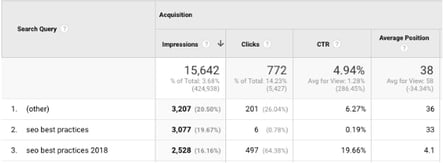
What is average click-through-rate and why does it matter? The average CTR is one of the most important metrics for any digital marketer looking to drive more traffic to their website. It is calculated by dividing total clicks by total impressions, then multiplied by 100. The equation will look like this:
CTR=(total clicks/total impressions) x 100
What exactly does average CTR tell us? The CTR is an important metric since it tells us how likely users will click through to your site in the SERPs compared to the competition. A low CTR would indicate that we are underperforming compared to the competitors, and a high CTR means that we are performing well against the competition. What then, is considered a low CTR? How about a high CTR? Though subjective, most marketers would mark anything below 1.5% CTR as underperforming and anything above 2.5% CTR as performing well, while anything in between would be considered average.
If your webpages currently fall under the 1.5% CTR, consider these 3 steps to improving your average click-through-rate:
Outsmart the Competition: Use Long-Tail Keywords
The biggest influencer of CTR is actually out of your control. You aren’t the only one who has a say on where users should click. Your competition has the biggest influence on this particular metric.
Too often, I see small companies attempting to compete with large brands by going after generic keywords. Targeting generic keywords is a good thing because you can cover a large audience. However, the downfall of targeting generic keywords is that everyone else in the industry is targeting that keyword. That means that competition is high and you’ll have to invest a whole lot more (be it dollars or man hours) to increase your CTR. And typically, these generic keywords are dominated by large companies who have a reputable online reputation.
To combat this, I recommend targeting long-tail keywords to increase CTR. Long-tail keywords are keywords that are more specific. Instead of targeting “car dealerships,” you could concentrate on “Honda dealerships in Atlanta.” There are multiple benefits to targeting long-tail keywords:
- There is less competition in the SERPs
- Since the nature of a long-tail keyword is to be specific, you’re tailoring to the specific needs of your audience
- Users searching for long-tail keywords are typically further along in the buying cycle and more likely to convert
I know the fear that comes with targeting long-tail keywords. Will my traffic drop because long-tail keywords have a smaller search volume? Targeting long-tail keywords can dramatically increase your CTR. Take a look a look at the example below:

Note that:
- The more generic keyword, “seo best practices,” has about 21% more impressions than the more modified long-tail keyword, “seo best practices 2018.”
- However, we received 497 clicks for the keyword “seo best practices 2018” compared to 6 for “seo best practices.”
- We have an unreal 19.66% CTR for “seo best practices 2018” compared to .19% for “seo best practices.”
- Our average position for “seo best practices” vs “seo best practices 2018” was 33 vs 4.1.
Use Structured Data to Modify How Your Site Appears In SERPs
For a long time, Google only allowed around 160 characters in the meta description. Recently, that number went up to about 280-300 characters (the exact number is still debatable). Does that mean that you only have 300 characters to tell users what your site is all about? Absolutely not!
Google has always prioritized user experience over all things. In the SERPs, Google provides users with additional information with the use of their rich snippets system. Rich snippets allow you to add star ratings, breadcrumbs, reviews, product price, and more to your results. The more information you provide to users, the more likely they are to click through to your page. Refer to the image below to see the additional information that was added to this search result for the book, “The Love Dare.” You can see ratings, how many reviews, the price, and whether or not it is in stock. Providing a good user experience in the SERPs will definitely help increase CTR.

Rich snippets can be dynamically applied to your search engine results snippet, however, we recommend applying structured data to your website. Structured data can take the form of JSON-LD (recommended), Microdata, or RDFa. You can use the schema.org site to help you optimize your pages, or you can use a JSON-LD generator.
We highly recommend providing more information to your users outside of the meta title and description to influence users to click on your site over the competitors.
Let Google Analytics & Search Console Make Your CTR Optimization Decisions
One thing you don’t want to do in SEO is “set it and forget it.” Anyone who works in SEO knows that its a marathon, not a sprint. It’s also important to note that just because you failed the first time, doesn’t mean you have to fail later down the road. The point I want to drive here is: make data-driven decisions to optimize old content. Let’s say you published a blog 3 months ago and the CTR never surpassed 1.5%. What’s the next step?
What I like to do is to use data from Google Analytics. Google Analytics gives you limited access to keywords that generated a page impression. This information can be access by following this click path:
Login>Acquisition>Search Console>Landing Pages>”Page URL”
Take a look at the data there. There will be times when you come across keywords that you are ranking well for, that are driving traffic to your page, but your page isn’t optimized well for that keyword. Take the opportunity to insert the keyword into your meta title, description, and multiples times in your content.
Do you still have questions about improving your organic click-through rate? Feel free to reach out to The Creative Momentum and we can help you devise a plan to increase CTR on your site, drive more traffic and increase conversions!


